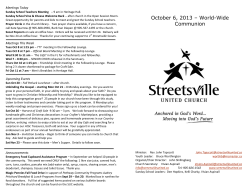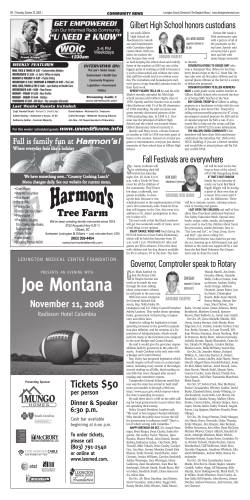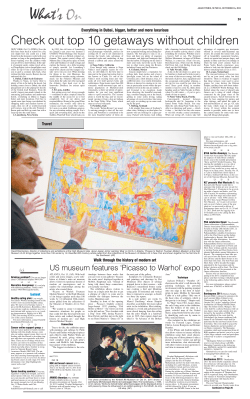
CH2M HILL /Dallas (914) 882-7766
2012 Canadian Society of Value Analysis Conference, Calgary, Alberta; October 2012 Why Commissioning and VM lead to efficient Asset Management Rock J. Antonios, PE, CBCP, AVS CH2M HILL DFW/Dallas [email protected] [email protected] iPhone: (914) 882-7766 Commissioning ASHRAE Guideline 0-2005 Scope of Work The owner has adopted the Cx process as his/her quality process to plan, design, construct and operate his facility as TQM. Cx process provides tools to enable everyone involved in the construction of the facility to verify that the OPR are met. CA applies ASHRAE Guideline 1.1-2007 for technical requirements of the Cx process. Cx: TQM: OPR: CA: BOD: BMS: TAB: Commissioning Total Quality Management Owner's Project Requirements Commissioning Agent Basis Of Design Building Management System Testing And Balancing Prepared by: Rock J. Antonios, PE, CBCP, AVS October 2012 1 Cx process during Pre-design phase Cx activities completed by CA include once Cx team is formed: • Developing and documenting the OPR. • Identifying a scope and budget for the Cx process. • Developing the initial Cx plan. • Acceptance of pre-design phase Cx activities. rja oct 2012 2 Cx process during Design phase Cx activities completed by CA include: • Work with Cx team to document the OPR for the facility, • Work with the design professionals in documenting the BOD, • Verify the BOD with regard to OPR, • Develop a Cx plan encompassing Design, Construction, Occupancy and Operations phases, • Determine the Cx requirements to include in construction documents and review by design team for integration into the specifications • Review design documentation developed by the design professionals, • Perform quality design review at 35%, 50%, 95% and 100%. rja oct 2012 3 Cx process during Construction phase Cx activities accomplished by CA include: • Organizes & schedules meetings to review the Cx process, • Develops the scope and coordinate, • Reviews submittals concurrent with the designers, • Completes checklist with contractors, • Verifies construction checklist to comply with OPR, • Develops specific test procedures & review with contractors, • Directs the execution of the tests performed by contractors, (See next slide) rja oct 2012 4 Cx process during Construction phase (cont.) • Documents the results of the tests after BMS & TAB are installed, • Documents the corrections and retesting of noncompliance items by the contractor, • Reviews the systems manual, • Reviews, pre-approves & verifies the training provided by contractors, • Verifies delivery of the Systems Manual. rja oct 2012 5 Cx process during Occupancy & Operations phase Cx activities accomplished by CA include: • Schedules and verifies testing deferred by Contractor, • Verifies continuing training, • Review of warranties two months before their expiration, • Schedules organizes attends lessons learned given by another team member, • Completes the Final Cx Report. rja oct 2012 6 Cx Benefits to the Project • • • • • • • • Less litigation. LEED credit points. Higher quality products, minimize breakdowns. Healthy buildings improve productivity. Energy savings and better reputation. Monitoring activities and “where do we stand” status. Reduction of operations and maintenance costs. Consistent documentation from inception – occupancy. rja oct 2012 7 CA Limit of Responsibility The CA documents OPR and design concept, design criteria, verifies that Code Consultant is on board for compliance with codes. CA is not responsible for design or general construction scheduling, cost estimating or construction management. CA assists with problems solving but responsibility resides with the General Contractor and design Professionals. rja oct 2012 8 VALUE METHODOLOGY PROCESS INFORMATION PHASE FIND OBJECTIVES, DEFINE SCOPE, COSTS FACTS. FUNCTION PHASE DETERMINE FUNCTIONS, REDEFINE PROJECT SCOPE, ANALYZE FUNCTION. CREATIVE PHASE CREATIVITY, APPLY IMAGINATION, ALLOW INCUBATION, DETERMINE ALTERNATE. EVALUATION PHASE ELIMINATE IDEAS DO NOT WORK COMBINE IDEAS DETERMINE IDEAS DEVELOPMENT PHASE ACTION PLAN FOR COMPLETION REFINE/DEVELOP IDEAS ESTABLISH BENEFITS PRESENTATION PHASE COMMUNICATE TO CREATIVITY TEAM AND TO CLIENT IMPLEMENTATION PHASE FOLLOW-UP PHASE CHAMPION RESPONSIBILITY ASSIGNED OVERCOMING ROADBLOCKS, RECOMMEND SPECIFIC And PRECISE ACTION IMPLEMENT SPECIFIC & PRECISE PROJECT ACTION PLANS COMMUNICATE TO CREATIVITY TEAM MONITOR CHANGES RECONVENE AS NECESSARY DOCUMENT RESULTS REPORT PROGRESS rja oct 2012 9 Information Air Handling Unit Key Questions What is it? Fan(s), coil(s) & filter(s) in a casing and mixing box. What does it do? Air condition & push air thru Terminal. What must it do? Pressurizing, Heating, cooling, dehumidifying and ventilating. What does it cost? Three to Four Fifty dollars per CFM of air supply however Fan Coils might cost Two dollars per CFM. How does it do it? Uses Chilled Water or Hot water with piping and Electrical Power; leak-free connection to ducting. When does it do it? Mostly during working hours. Why does it do it? To bring comfort to people. rja oct 2012 10 Function DETERMINE FUNCTIONS REDEFINE PROJECT AND SCOPE ANALYZE FUNCTION DETERMINE COST-FUNCTION RELATIONSHIP rja oct 2012 1 1 Creative CREATIVE PHASE FOCUSED ON SELECTIVE FUNCTIONS GENERATED ALTERNATE IDEAS CATEGORIZED EACH FUNCTION rja oct 2012 12 Evaluation EVALUATION PHASE PRIORITIZE FUNCTION WITHIN CATEGORIES SELECT HIGHEST RANKED FUNCTIONS GROUP FUNCTIONS FOR T-CHART ANALYSIS rja oct 2012 13 Development 1. Fan wall vs. single centrifugal fan and return fan on all AHU’s, 2. Coils copper tubes and fins vs. copper tubes with Aluminum fins, 3. Metal gauge galv. steel 16 exterior & 20 interior and Insulation 2” foam vs. 3” rigid Fiber Glass, 4. Stainless Steel Coil Casing vs. Galvanized, 5. Pre-construct Section Splits vs. compact built, 6. Leakage 1.5% at 12” Pressure Differential, 7. Build Industrial versus commercial Strength, rja oct 2012 14 (Development suite) 8. Competitively priced at capital cost, 9. Low cost of ownership, constructability and easy maintenance, 10.Cost efficiency: capital cost, operating cost & reliability, 11.Stainless Steel Drain Pans 304 vs. 316 12.Air flow measuring stations in the damper or duct mounted devices, 13.Biological or Activated Carbon Filtration, 14.Spare Filters reduction of cost at initial cost. rja oct 2012 15 Presentation Design including enlarged plans, sections and details of installation. Implementation Coordinate with all stakeholders, design team, supplier and implementation group. 16 rja oct 2012 Follow-up 17 rja oct 2012 TRUE DEFINITION OF ASSET MANAGEMENT •All mechanical systems are made of assets buried or visible, • Assets lose value over time as systems age & deteriorate, •Difficulty to deliver the service that the customer wants, •O & M increase and utility or owner faces excessive costs, •Utility, owner or company cannot afford and goes down, •Therefore Asset Management assists in making right decisions in managing aging assets whether renew, rehab or disposal. Benefits of Asset Management •Better operational decisions and improved 911responses, •Plan and pay for future repairs and replacements, •Increased knowledge of assets location and critical ones, •Efficient op and communication with customers & capital improvement projects to meet true needs of the system. 18 rja oct 2012 ASSET MANAGEMENT GOALS IN MANAGING INFRASTRUCTURE ASSETS MEET THE REQUIRED LEVEL OF SERVICE IN COST EFFECTIVE MANNER PRESENT AND FUTURE WITH KEY ELEMENTS AS FOLLOWS: •Taking a life cycle approach, •Developing cost-effective management strategies for the long term, •Providing a defined level of service and monitoring performance, •Understanding and meeting the demands of growth thru infrastructure investment, •Managing risks with asset failures, •Sustainable use of physical resources, •Continuous improvement in asset management practices. rja oct 2012 19 VISION Support community learning; health, social and environmental well-being and economic growth, ensuring a sustainable future for all. MISSION Provide leadership, direction and responsible stewardship of resources and delivery of cost efficient key services to our community. rja oct 2012 20 USEFUL LIFE 21 LIKELIHOOD OF FAILURE VS. COST OF FAILURE 22 Basic options for dealing with the actual assets over time: 1. Operate and maintain the existing assets. 2. Repair the assets as they fail. 3. Rehabilitate the assets. 4. Replace the assets. 23 Operation and Maintenance Expenditure by Criticality Expenditure Percentage of the Total Expenditure Asset A B C D O&M Dollars $5 $15 $30 $50 Out of a $100 dollar 5% 15% 30% 50% High Likelihood of Failure B D A Low C High Consequences of Failure 24 Conclusion: Commissioning and Value Methodology applied sciences to a project or a system improve quality, enable savings and lead to comprehensive, innovative and sustainable Asset Management. Questions? Thank You! rja oct 2012 25
© Copyright 2026









